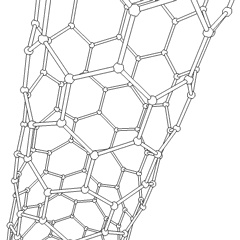Nanochemistry:
Nanotubes
What are Nanotubes?
Carbon Nanotubes are a tube-shaped, and are synthesized using carbon atoms linked in a hexagonal arrangement to form a graphite layer. The graphite layer is rolled into a tube with a diameter measuring on the nanometer scale (10^-9 m).
Carbon Nanotubes can be synthesized into a wide variety of structures, with different lengths, number of layers, types of helicity and thickness of the tubes. As such, their electrical properties can vary based on these differences to have properties similar to either as metals or semiconductors.
Carbon Nanotubes are usually synthesized to have diameters ranging from less than 1 nm to a relatively larger width of 50 nm. The lengths of carbon nanotubes are often only several micrometers. However, recent developments in carbon nanotubes research have resulted in the successful synthesis of nanotubes that can measured in the scale of centimeters, which is a lot longer than that with previous methods. This opened up the possibility for more potential uses of carbon nanotubes.





